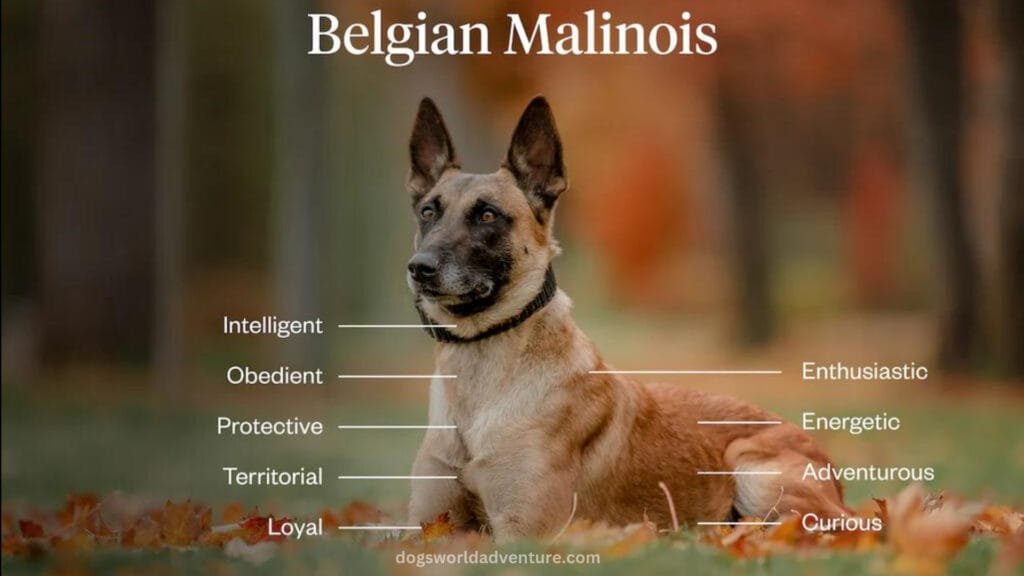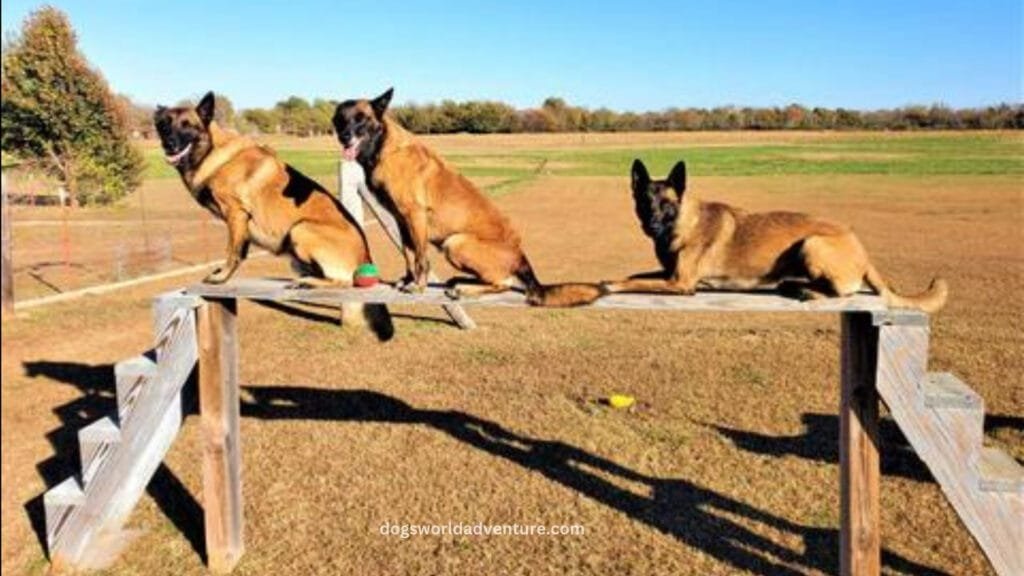The Belgian Malinois is a smart and hardworking dog that’s known for its loyalty and strong instincts. Originally bred in Belgium to herd sheep, these dogs have become popular in roles like police work, military tasks, and search-and-rescue missions because of their focus and quick learning. With their sleek, muscular bodies and sharp minds, Belgian Malinoi stand out as one of the most versatile and skilled dog breeds in the world.
Though they are excellent working dogs, Belgian Malinoi can also make great pets for active families. They need lots of exercise, training, and mental challenges to stay happy. They’re protective and devoted to their owners, making them great watchdogs. However, they can be a bit too energetic for families with small children or people who aren’t very active. If you’re looking for a loyal, smart, and active dog, the Belgian Malinois might be a perfect fit for you.
History of the Belgian Malinois
The Belgian Malinois originated in Belgium, where it was initially bred for herding sheep. In the late 19th century, these dogs were grouped into four types of Belgian shepherd dogs, with the Malinois being one of the most recognized today. Their name comes from the city of Malines, where the breed was popular among farmers and herders.
Over time, the Belgian Malinois’s strong work ethic and sharp intelligence made them more than just herding dogs. By the early 20th century, they were being used for police and military work due to their ability to follow commands, stay focused, and react quickly in high-stress situations.
During World War I, the Belgian Malinois served as messengers, ambulance dogs, and even helped pull carts loaded with supplies. Their bravery and loyalty during the war solidified their reputation as one of the best working dogs in the world.
Today, they continue to work in law enforcement and the military, often trained for roles such as detecting explosives, drugs, and even finding missing persons. But their versatility also allows them to work in therapy, search and rescue, and as personal protection dogs.
Quick Facts About the Belgian Malinois
- Breed Origin: Belgium, originally bred for herding.
- Size: Medium-sized; males are 24-26 inches tall, females are 22-24 inches tall.
- Weight: Typically 40-80 pounds.
- Lifespan: 12 to 14 years.
- Coat: Short, straight, and weather-resistant. Common colors include fawn, mahogany, and red with black markings.
- Temperament: Loyal, intelligent, brave, and energetic.
- Exercise Needs: At least 1-2 hours of daily activity.
- Training: Highly trainable but requires consistency and mental challenges.
- Best For: Active families, experienced dog owners, and those looking for working dogs.
- Jobs: Often used in police, military, search-and-rescue, and guard work.
- Common Health Issues: Hip dysplasia, elbow dysplasia, and progressive retinal atrophy (PRA).
- Grooming: Moderate; they shed heavily twice a year and require weekly brushing.
- Good With Kids: Yes, but best for older children due to their high energy levels.
- Living Conditions: Can live in apartments if given enough exercise, but they thrive in homes with yards.
- Special Traits: Known for their agility, speed, and sharp sense of smell.
Belgian Malinois vs. Other Shepherd Breeds
There are several different types of Belgian shepherd dogs, including the Groenendael, Laekenois, Tervuren, and the Malinois. While all these dogs share common traits—such as intelligence, loyalty, and a strong work ethic—the Belgian Malinoi stands out for its sleek, short coat and high energy levels.

Compared to other shepherd breeds, such as the German Shepherd, the Belgian Malinoi is slightly smaller and leaner. They’re faster and more agile, which is one reason they’re favored in police and military work. Although German Shepherds are also highly skilled working dogs, the Malinois has gained popularity due to their stamina and drive.
Physical Appearance of the Belgian Malinois
Belgian Malinois dogs are medium-sized but muscular and lean. Males typically weigh between 60 to 80 pounds, while females are slightly smaller, weighing 40 to 60 pounds. Their height ranges from 22 to 26 inches, with females being a bit shorter.
They have a short, straight coat that is typically fawn or mahogany in color with a black mask on their face. Their ears stand erect, and their eyes are dark and filled with intelligence and alertness. The coat of a Belgian Malinoi is weather-resistant, which helps them work outdoors in different climates without much discomfort.
Because of their active and athletic nature, they have a well-muscled body. This muscular build, combined with their sleek appearance, gives them an elegant yet powerful look. Their agility, speed, and stamina are second to none in the dog world, which is why they’re often the top choice for challenging physical tasks.
Belgian Malinois Personality and Temperament
The Belgian Malinois is known for its keen intelligence and boundless energy. These dogs are quick learners and excel in obedience training, but they also require a strong, consistent leader. They are very devoted to their families and form strong bonds with their owners. However, their protective nature means they can be wary of strangers, making them excellent watchdogs.
One thing to remember about Belgian Malinoi is that they are not couch potatoes. These dogs are constantly looking for something to do, whether it’s playing fetch, learning a new trick, or just running around the yard. Because of this, they are best suited for active owners who can provide them with plenty of physical and mental stimulation.

Despite their serious nature when working, Belgian Malinois can be playful and affectionate with their families. They love to be included in activities and are happiest when they have a job to do or a game to play. If they are not given enough exercise or stimulation, they may become bored, which can lead to destructive behaviors such as chewing or excessive barking.
Are Belgian Malinois Good Family Dogs?
Belgian Malinois can make great family pets, but they require the right environment. These dogs thrive in active households where they can be a part of daily activities. If you enjoy hiking, running, or spending a lot of time outdoors, a Belgian Malinois can be the perfect companion.
However, because of their high energy levels, they may not be the best fit for families with very young children. They can be a bit rough in their play, and their herding instincts might lead them to try to “herd” children by nipping at their heels. Early training and socialization can help curb these behaviors, but supervision is always necessary around small kids.
For families with older children or those who enjoy spending time outside, a Belgian Malinois can be a loyal and loving family member. They are also very protective, which can make them excellent guardians of the home.
Read also: American Eskimo Dog: The Friendly, Fluffy Companion for Families
Training a Belgian Malinois
Training a Belgian Malinois is essential. These dogs are extremely intelligent and learn quickly, but their intelligence also means they can be stubborn at times. They need firm, consistent training from an early age to prevent them from developing bad habits.
Start training as soon as you bring your Malinois home. Basic commands like “sit,” “stay,” and “come” are important, but these dogs can go much further. They thrive on learning new tasks and can easily be trained in advanced obedience, agility, and even specialized skills like search and rescue.

Positive reinforcement works best with this breed. Rewarding good behavior with treats, praise, and playtime will encourage them to continue learning. Avoid harsh corrections, as this can make them nervous or lead to stubbornness.
Socialization is equally important for Belgian Malinois. Expose them to a variety of people, animals, and environments while they’re young. This will help them grow into well-rounded dogs who are comfortable in different situations. If they’re not socialized properly, their protective instincts can lead to aggression toward strangers or other dogs.
Exercise Needs of a Belgian Malinois
One of the most important things to know about Belgian Malinois is that they need a lot of exercise. A simple walk around the block isn’t enough for these dogs. They need at least 90 minutes to two hours of exercise each day to keep them happy and healthy.
Running, hiking, playing fetch, and agility training are great ways to help them burn off energy. Because they are so intelligent, mental exercise is just as important as physical exercise. Teaching them new tricks, giving them puzzle toys, or working on advanced commands will keep their minds sharp and prevent boredom.
Without enough exercise, Belgian Malinois can become destructive. They might chew on furniture, dig up the yard, or bark excessively if they don’t have enough outlets for their energy. Providing them with plenty of physical and mental stimulation will help prevent these behaviors.
Diet and Nutrition
Belgian Malinois are high-energy dogs, so they need a diet that supports their active lifestyle. A high-quality dog food that is rich in protein is essential for keeping them in peak condition. Look for dog food with real meat as the first ingredient, and avoid foods with fillers like corn or soy.
You can choose between dry kibble, wet food, or a combination of both. Some owners also opt for a raw food diet, but it’s important to consult with your vet to make sure this is a safe and balanced option for your dog.
Belgian Malinois should be fed twice a day—once in the morning and once in the evening. The amount of food they need depends on their age, weight, and activity level. Active dogs will need more food than those who are less active.
Make sure they always have access to fresh water, especially after exercise.
Common Health Issues
Like all breeds, Belgian Malinois can suffer from certain health problems. While they are generally healthy dogs, it’s important to be aware of potential issues so you can catch them early and keep your dog healthy.
- Hip Dysplasia: This is a common issue in many large and active dog breeds. Hip dysplasia occurs when the hip joint doesn’t develop properly, leading to pain and arthritis. Regular vet check-ups and maintaining a healthy weight can help reduce the risk.
- Elbow Dysplasia: Similar to hip dysplasia, this condition affects the elbow joints and can cause lameness or arthritis. Keeping your dog at a healthy weight and providing the right exercise can help prevent this.
- Eye Problems: Belgian Malinois can be prone to certain eye conditions, including cataracts and progressive retinal atrophy (PRA). Regular eye exams can help detect these issues early.
- Bloat: This is a serious condition that can affect deep-chested dogs like the Belgian Malinois. Bloat occurs when the stomach fills with gas and twists, which can be life-threatening. Feeding your dog smaller meals and avoiding vigorous exercise right after eating can help reduce the risk.
With proper care, a Belgian Malinois can live a long and healthy life, typically between 12 and 14 years.
Grooming a Belgian Malinois
Belgian Malinois have a short, straight coat that is relatively easy to care for, but they do shed a lot, especially during the shedding seasons in spring and fall. Regular brushing is important to keep their coat looking healthy and to reduce the amount of loose fur around your home. Brushing them at least once a week is recommended, but during the shedding seasons, you may need to brush them more frequently to keep the fur under control.
While their coat doesn’t require much trimming or special care, it’s important to check their ears regularly for dirt or signs of infection. Use a cotton ball and a vet-approved ear cleaner to gently clean their ears if needed. Regularly trimming their nails is also necessary to prevent overgrowth, which can cause discomfort when walking or running. If you can hear their nails clicking on the floor, it’s time for a trim.
Dental hygiene is another key aspect of grooming. Brush your Belgian Malinois’s teeth a few times a week to prevent tartar buildup and ensure their gums stay healthy. You can use dog-specific toothpaste and a soft-bristle toothbrush for the best results.
Is a Belgian Malinois a Good Fit for You?
Belgian Malinois are wonderful dogs, but they are not for everyone. Their high energy levels, intelligence, and need for constant mental and physical stimulation mean they require an owner who can keep up with them. If you’re an active person who enjoys hiking, running, or spending time outdoors, a Belgian Malinois might be the perfect fit. They thrive in homes where they can be involved in daily activities and where they are given plenty of opportunities to exercise and learn new skills.
However, if you have a busy schedule or prefer a more low-energy pet, this breed might not be the best choice. Belgian Malinois can become destructive or anxious if they are bored or under-exercised. They are happiest when they have a job to do, whether it’s learning new tricks, participating in dog sports, or helping with tasks around the home.
Additionally, Belgian Malinois can be protective and territorial, which makes them excellent watchdogs, but they need to be socialized from a young age to ensure they don’t become overly suspicious or aggressive toward strangers. Early training and socialization are crucial to helping them become well-adjusted, confident adults.
Belgian Malinois as Working Dogs
One of the most impressive aspects of the Belgian Malinois is their ability to excel in various working roles. These dogs are often employed by police, military, and search-and-rescue teams because of their sharp instincts, intelligence, and willingness to work. They are frequently trained to detect explosives, drugs, and even human scents in search-and-rescue missions.
Belgian Malinois are often seen in high-profile roles, such as assisting in military operations. For example, a Belgian Malinois was part of the team that helped take down Osama bin Laden, showing just how fearless and capable these dogs are in dangerous situations.
Their excellent sense of smell and agility also make them ideal for tracking tasks and search missions. In some cases, they are even trained to assist people with disabilities, helping them navigate the world with greater independence.
When working in these demanding environments, the Belgian Malinois’s focus and drive really shine. They are able to stay calm under pressure, follow complex commands, and remain dedicated to their tasks, making them one of the most reliable working dog breeds in the world.
Belgian Malinois in Dog Sports
Belgian Malinois are not only outstanding working dogs, but they also excel in various dog sports. These activities tap into their high energy levels and intelligence, allowing them to compete and shine in competitions that require skill, speed, and agility.
Some popular dog sports that Belgian Malinois excel in include:
- Agility: Agility competitions require dogs to navigate obstacle courses filled with jumps, tunnels, weave poles, and other challenges. Belgian Malinois are perfect for this sport due to their speed, agility, and ability to follow commands quickly.
- Obedience: Obedience trials test how well a dog can follow commands and perform tasks in a controlled environment. The Belgian Malinois’s intelligence and eagerness to please make them excellent competitors in these events.
- Protection Sports: Belgian Malinois are often trained in protection sports like Schutzhund, which tests a dog’s tracking, obedience, and protection skills. These sports mimic real-life working scenarios where dogs must protect their handlers or track down objects based on scent.
- Herding Trials: Because the Belgian Malinois was originally bred as a herding dog, they can also compete in herding trials where their natural instincts to herd and control livestock are tested.
Participating in dog sports is a great way to keep your Belgian Malinois active and mentally stimulated. It also provides an outlet for their natural abilities and energy, which can prevent boredom and destructive behaviors.
Belgian Malinois and Other Pets
When it comes to other pets, Belgian Malinois can get along well with them if they are socialized properly. However, because they have strong herding and prey instincts, they may be inclined to chase smaller animals such as cats or rabbits. Early socialization and training can help curb this behavior, but it’s important to supervise interactions between your Belgian Malinois and other pets, especially if they are unfamiliar with each other.
In households with multiple dogs, Belgian Malinois can usually get along well, but they may be dominant and want to establish themselves as the leader. If you already have other dogs at home, careful introductions and supervision will help ensure that they get along and respect each other’s space.
Belgian Malinois Lifespan and Aging
Belgian Malinois generally have a lifespan of 12 to 14 years, which is quite typical for medium to large dog breeds. As they age, they may experience some of the common health issues associated with their breed, such as hip and elbow dysplasia, arthritis, or eye problems. Regular vet visits and a healthy diet will help manage these issues and ensure your dog lives a long, happy life.
As your Belgian Malinois gets older, you may notice a decrease in their energy levels. While they may not be able to run or play as much as they used to, it’s still important to keep them mentally stimulated with interactive toys, training exercises, and shorter walks or gentler play sessions.
Caring for a Senior Belgian Malinois
When caring for a senior Belgian Malinois, adjusting their diet and exercise routine to meet their changing needs is important. Older dogs may require a diet with fewer calories to prevent weight gain, but they still need high-quality protein to maintain muscle mass.
Their exercise routine should be modified to account for any joint or mobility issues. Instead of long, intense runs, opt for shorter, more frequent walks or gentle play sessions. Providing them with soft bedding and making sure they have a comfortable place to rest is also important, especially as they get older and may develop arthritis or other joint issues.
Keeping their minds active is just as important as their physical health. Continue teaching them new tricks, introducing puzzle toys, or giving them tasks around the house, such as retrieving small items or following commands.
Conclusion
The Belgian Malinois is a remarkable breed with unmatched intelligence, energy, and dedication. Whether as a loyal family companion, a working dog, or a competitor in dog sports, these dogs excel in everything they do. However, owning a Belgian Malinois comes with responsibility. They need an active lifestyle, consistent training, and plenty of mental stimulation to stay happy and healthy.
For the right owner, a Belgian Malinois can be a lifelong friend and protector. If you’re willing to invest the time and effort into training, exercising, and caring for them, they will reward you with unwavering loyalty and love. Whether you’re looking for a working dog, a sports companion, or an energetic family pet, the Belgian Malinois has the heart and drive to meet your needs.
FAQS
1. Are Belgian Malinois good with kids?
Yes, they can be good with kids, but they need early training and socialization. Their high energy levels and herding instincts mean they may accidentally knock over small children, so supervision is important.
2. How much exercise does a Belgian Malinois need?
Belgian Malinois need at least 90 minutes to two hours of exercise daily. This includes physical activities like running, hiking, and playing, as well as mental exercises like training and puzzle toys.
3. Do Belgian Malinois shed a lot?
Yes, they shed heavily, especially during the spring and fall shedding seasons. Weekly brushing helps manage the shedding, and during shedding seasons, more frequent brushing is necessary.
4. Are Belgian Malinois easy to train?
Yes, they are highly intelligent and quick learners, but they can also be stubborn. Consistent, positive reinforcement works best, and early training is crucial to ensure they develop good habits.
5. Can Belgian Malinois live in an apartment?
Belgian Malinois can live in an apartment, but only if their exercise needs are met. They need plenty of physical and mental stimulation to prevent boredom, which can lead to destructive behaviors.
6. How long do Belgian Malinois live?
With proper care, a Belgian Malinois can live for 12 to 14 years.
7. Are Belgian Malinois aggressive?
Belgian Malinois are protective and can be wary of strangers, but they are not naturally aggressive if properly trained and socialized. Early socialization helps prevent issues with aggression.
8. Do Belgian Malinois get along with other dogs?
They can get along with other dogs, but early socialization is important. Belgian Malinois may try to assert dominance, so careful introductions are necessary when introducing them to other dogs.
9. How much grooming do Belgian Malinois need?
They have a short coat that requires weekly brushing. They shed a lot, especially during shedding seasons, so extra brushing is needed during those times.
10. What is the best diet for a Belgian Malinois?
A high-quality diet rich in protein is essential for this active breed. You can feed them dry kibble, wet food, or a combination of both, but always ensure it meets their nutritional needs based on their activity level.







